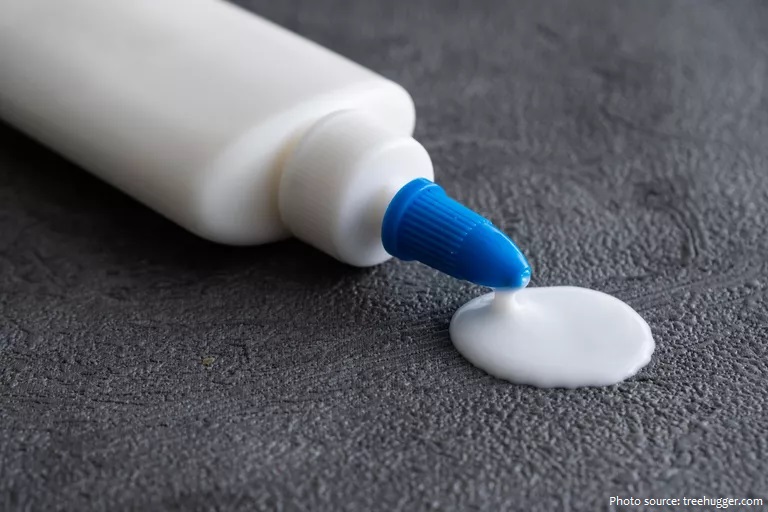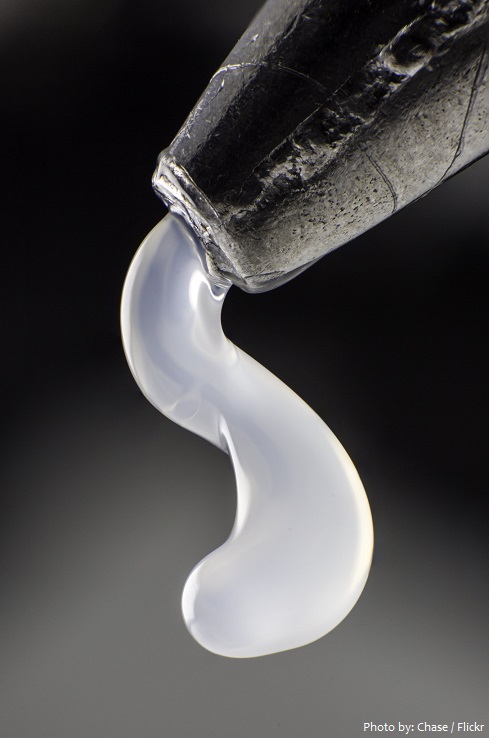
Glue is gelatin-like adhesive substance extracted from animal tissue, particularly hides and bones, or from fish, casein (milk solids), or vegetables.
Glue history reaches all the way back to prehistoric times when our ancestors used simple glues to easily manage tools they needed to use for their survival.
Around 200,000 years ago, our Neanderthal ancestors made spears by bonding a flint point to a wooden shaft. The clever bit comes from the fact that tar glue made from tree bark was used to join the flint and wood together. Scientists thought that extracting tar glue from birch bark would be a step too advanced for Neanderthals, but evidence of the use was found in archaeological finds from the Middle Pleistocene era (circa 200,000 years ago). In reality, in 2017, scientists at Leiden University, Holland, found that tar glue could be made by simply heating rolls of birch bark over an open fire. More proof that Neanderthals were a lot more creative than their previously popular image.
Oldest use of glue in decorative works – Nahal Hemar Cave, located on a cliff near the Dead Sea, Israel, was found to contain some very unusual artifacts. Human skulls, carbon dated to 8,310-8,110 years ago, were found decorated with criss-cross designs that proved to be made of a collagen glue. Excavated in 1983 by a team from Harvard University and the Israel Antiquities Authority, the cave contained objects such as rope baskets, embroidered fabrics, nets, wooden arrowheads, and bone and flint utensils, as well as the decorated human skulls. Collagen glue is made from animal fats and tissue, and prior to this exceptionally old use in decorative works, the oldest use of this glue was by Egyptians some 4,000 years ago to bind pigments in paint. The Nahal Hemar skulls are to this day the oldest use of glue in decorative work.
Archeologists excavating burial sites from 4000 BC have discovered clay pots repaired with glue made from tree sap. We know that the ancient Greeks developed adhesives for use in carpentry, and created recipes for glue that included the following items as ingredients: egg whites, blood, bones, milk, cheese, vegetables, and grains. Tar and beeswax were used by the Romans for glue.

In 2000, a paper revealed the discovery of a 5,200-year-old man nicknamed the “Tyrolean Iceman” or “Ötzi”, who was preserved in a glacier near the Austria-Italy border. Several of his belongings were found with him including two arrows with flint arrowheads and a copper hatchet, each with evidence of organic glue used to connect the stone or metal parts to the wooden shafts. The glue was analyzed as pitch, which requires the heating of tar during its production. The retrieval of this tar requires a transformation of birch bark by means of heat, in a process known as pyrolysis.
Animal glue was first introduced in Ancient Egypt some 4 thousand year ago, which is earliest known confirmation of use of glues that were made by prolonged boiling of animal hides, hooves and connective tissue. The most popular uses of glue (which was very expensive and rare) in that time was reinforcing the durability of papyrus scrolls, and creating furniture for nobility. Several examples of such furniture were preserved in tombs of Pharaohs, including casket of Tutankhamun.

Ancient Greeks and Romans later used animal and fish glue to develop veneering and marquetry, the bonding of thin sections or layers of wood. Animal glue, known as taurokolla in Greek and gluten taurinum in Latin, were made from the skins of bulls in antiquity. Broken pottery might also be repaired with the use of animal glues, filling the cracks to hide imperfections
About 906–618 BC, fish, ox horns and stag horns were used to produce adhesives and binders for pigments in China. Animal glues were employed as binders in paint media during the Tang Dynasty. They were similarly used on the Terracotta Army figures.
In Europe, glue fell into disuse until the period 1500–1700 AD. At this time, world-renowned cabinet and furniture makers such as Thomas Chippendale and Duncan Phyfe began to use adhesives to hold their products together.

In 1690, the first commercial glue plant was established in The Netherlands. This plant produced glues from animal hides.
In 1750, the first British glue patent was issued for fish glue. The following decades of the next century witnessed the manufacture of casein glues in German and Swiss factories.
In 1876, the first US patent (number 183,024) was issued to the Ross brothers for the production of casein glue.
Super Glue was invented by accident in 1942 by Dr. Harry Coover. He was attempting to make clear plastic gun sights to be put on guns used by Allied soldiers in WWII. One particular formulation he came up with didn’t work well for gun sights, but worked fantastically as an extremely quick bonding adhesive. Surprisingly, despite the commercial potential of such a product, Coover abandoned that formulation completely as it obviously wasn’t suitable for his current project, being too sticky. Today the substance is somewhat of a household necessity, with uses ranging from simple woodworking and appliance repair to industrial binding and medical applications.
Strongest natural glue – in 2006, researchers at Indiana University, USA, found that the bacterium Caulobacter crescentus produced a sticky substance that allowed it to attach to virtually any surface and even under water. The bacteria produced a mixture of long sugar-based molecules called polysaccharides that are around 7 times stronger than a Gecko’s sticky foot! The scientists measured 14 bacteria attaching themselves to a borosilicate substrate (glass-like base) and found it took a force between 0.11 to 2.26 micro-Newtons, averaging 0.59 ± 0.62 micro-Newtons, to detach the microbe. This equates to a ripping force of around 70 Newtons per square millimetre (10,153 pound-force per square inch) force over all compared to commercial ‘super’ glue (cyanoacrylate) that fails at around 25 newtons per square millimetre (3,626 pound-force per square inch). The report on the research appeared in the Proceedings of the National Academy of Science.
The heaviest weight lifted with glue (non-commercially available) is 17.48 tonnes (38,536 lb) and was achieved by Delo (Germany) in Windach, Germany, on 12 July 2019. The adhesive was specially produced for the record attempt, only 3 g (0.11 oz) were used to keep the truck suspended in the air for one hour.

